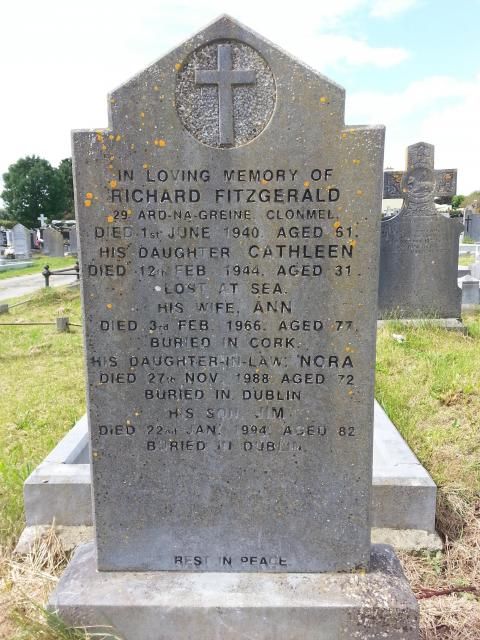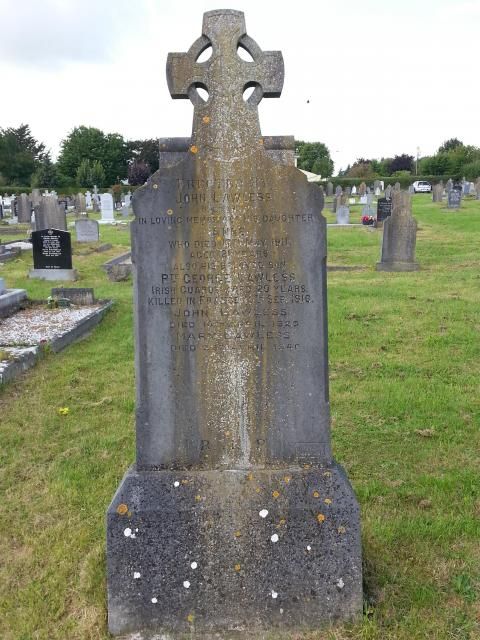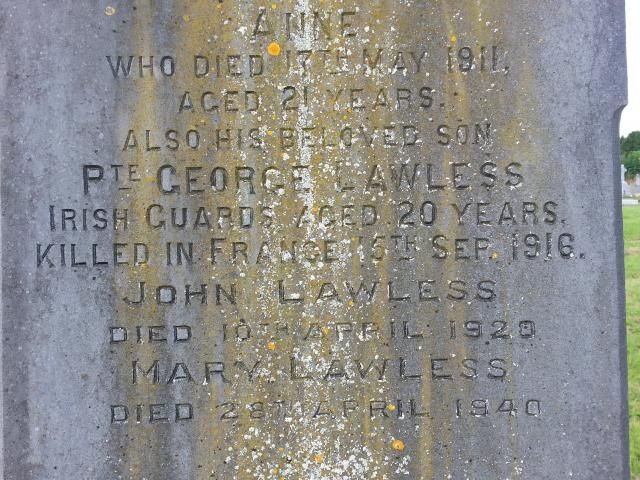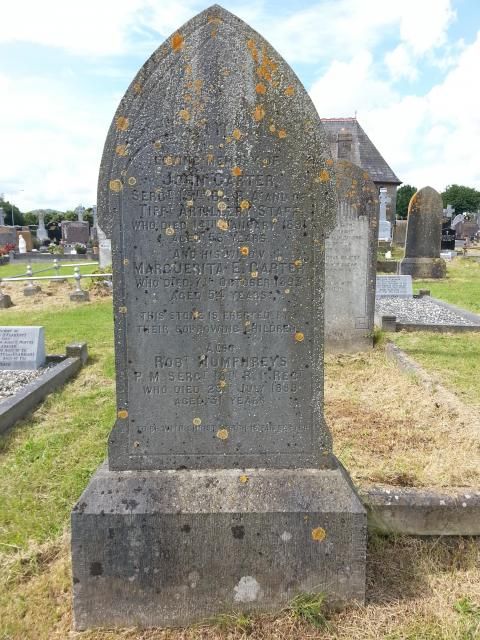Post by groundhog on Aug 10, 2014 20:12:16 GMT
Cemeteries are great places to go to find out obscure bits of history. Take note of interesting burials and do a little research and you'll find some great stuff like the link between the burial place of the Fitzgerald family and one of the worst maritime disasters of WW2 or the story of a Clonmel-born RAF pilot and the Danish resistance.
The land for the new cemetery was purchased from James Jameson, Malahide, Dublin. The cemetery opened for burials in 1886 and the first interment was that of Robert Sargint in Section 7 Row Ja, Grave 56 on 30th August 1886. So far the oldest military burial I have come across is that of Sgt Robert Humphreys, Royal Irish Regiment, who died 25th July 1889.
Charles Dillon served in 299 Squadron RAF. The Squadron was formed on 4th November 1943 from 'C' flight 297 Squadron at RAF Stoney Cross, Hampshire. 299 was a Special Operations squadron, dropping Allied Agents into Occupied Europe and supplying resistance groups. They were equipped with Short Stirling Bombers. In addition 299 Squadron dropped Paratroopers and towed gliders on D-Day, at Arnhem and on Operation Varsity, the Rhine crossing in January 1945. After the war the squadron took up transport duties, ferrying occupation troops to Denmark & Norway and service personnel home to Britain.
On the night of 2nd/3rd April 1945 three Stirlings of 299 Squadron were tasked to drop weapons to the Danish resistance on Orø Island in the Isefjorden. The cloud cover was very thick and two of the planes turned back, while Stirling LJ942 carried on, piloted by P/O Charles Dillon. He had joined 299 Squadron in May 1944, and they had flown with supplies and troops on D-Day, to Arnhem and during the attack across the Rhine. In addition to that they had flown several sorties with supplies for the resistance movements in France, Holland and Norway - and two bombing raids. Unable to establish their position, Dillon started circling over Hundested and came under German AA fire from Melby. His plane was hit in the tail section and began to lose height and crashed into Roskilde Fjord. 600 metres north of Stenø and about 100 metres from land. W/O Thomas McBeath, a Canadian, was killed in the crash with F/Sgt. Harold Farmer (flight engineer) and F/Sgt. Cyril Laing (wireless operator) seriously injured. Dillon suffered minor head injuries. The two other survivors, W/O H. J. Hart (navigator) and W/O R. A. Hills (rear gunner) were unhurt. The five airmen waded ashore and with the help of some fishermen Hills and Hart were transported to Sweden while the three injured men were taken to hospital in Frederikssund. The Germans picked up Farmer and Laing in the Hospital while Dillon was taken out of the back door. Dillon spent a couple of days hiding at a farm before he went on to Sweden.On 21st July 1945 he returned to Denmark on a mission and met some of the Danes who had helped him escape.
On 7th October 1945 Dillon was the pilot of Stirling LJ668 of 299 Sqdn, a special transport flight carrying a crew of 6 and 20 passengers from Cairo to London. Airborne for 9 hours and with fuel supplies running low Dillon attempted an emergency landing at Rennes airfield in France. Banking left over the airfield the aircraft hit the ground and was completely destroyed by fire. There were no survivors. The dead included six females and three married service couples. They are all buried in Rennes Communal Cemetery. Charles Dillon is commemorated on the family headstone in St. Patrick's Cemetery, Clonmel.
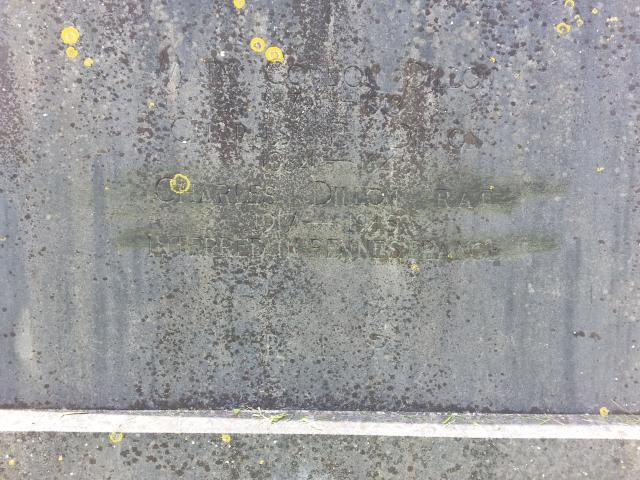
The Dillon Family headstone in St. Patrick's Cemetery, commemorating P/O Charles Dillon
St. Patrick's Cemetery
The land for the new cemetery was purchased from James Jameson, Malahide, Dublin. The cemetery opened for burials in 1886 and the first interment was that of Robert Sargint in Section 7 Row Ja, Grave 56 on 30th August 1886. So far the oldest military burial I have come across is that of Sgt Robert Humphreys, Royal Irish Regiment, who died 25th July 1889.
RAF Commemorations
190476 Flying Officer Charles Dillon 2/ 58/Gb
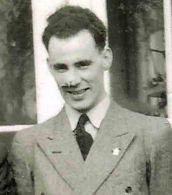
Charles Dillon
190476 Flying Officer Charles Dillon 2/ 58/Gb

Charles Dillon
Charles Dillon served in 299 Squadron RAF. The Squadron was formed on 4th November 1943 from 'C' flight 297 Squadron at RAF Stoney Cross, Hampshire. 299 was a Special Operations squadron, dropping Allied Agents into Occupied Europe and supplying resistance groups. They were equipped with Short Stirling Bombers. In addition 299 Squadron dropped Paratroopers and towed gliders on D-Day, at Arnhem and on Operation Varsity, the Rhine crossing in January 1945. After the war the squadron took up transport duties, ferrying occupation troops to Denmark & Norway and service personnel home to Britain.
On the night of 2nd/3rd April 1945 three Stirlings of 299 Squadron were tasked to drop weapons to the Danish resistance on Orø Island in the Isefjorden. The cloud cover was very thick and two of the planes turned back, while Stirling LJ942 carried on, piloted by P/O Charles Dillon. He had joined 299 Squadron in May 1944, and they had flown with supplies and troops on D-Day, to Arnhem and during the attack across the Rhine. In addition to that they had flown several sorties with supplies for the resistance movements in France, Holland and Norway - and two bombing raids. Unable to establish their position, Dillon started circling over Hundested and came under German AA fire from Melby. His plane was hit in the tail section and began to lose height and crashed into Roskilde Fjord. 600 metres north of Stenø and about 100 metres from land. W/O Thomas McBeath, a Canadian, was killed in the crash with F/Sgt. Harold Farmer (flight engineer) and F/Sgt. Cyril Laing (wireless operator) seriously injured. Dillon suffered minor head injuries. The two other survivors, W/O H. J. Hart (navigator) and W/O R. A. Hills (rear gunner) were unhurt. The five airmen waded ashore and with the help of some fishermen Hills and Hart were transported to Sweden while the three injured men were taken to hospital in Frederikssund. The Germans picked up Farmer and Laing in the Hospital while Dillon was taken out of the back door. Dillon spent a couple of days hiding at a farm before he went on to Sweden.On 21st July 1945 he returned to Denmark on a mission and met some of the Danes who had helped him escape.
On 7th October 1945 Dillon was the pilot of Stirling LJ668 of 299 Sqdn, a special transport flight carrying a crew of 6 and 20 passengers from Cairo to London. Airborne for 9 hours and with fuel supplies running low Dillon attempted an emergency landing at Rennes airfield in France. Banking left over the airfield the aircraft hit the ground and was completely destroyed by fire. There were no survivors. The dead included six females and three married service couples. They are all buried in Rennes Communal Cemetery. Charles Dillon is commemorated on the family headstone in St. Patrick's Cemetery, Clonmel.

The Dillon Family headstone in St. Patrick's Cemetery, commemorating P/O Charles Dillon


